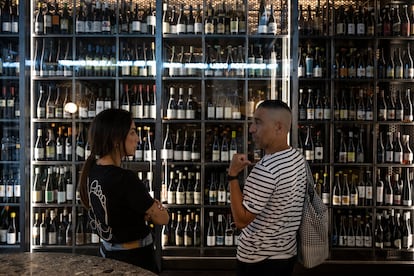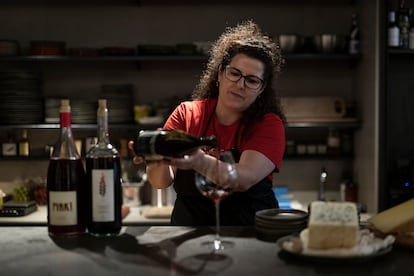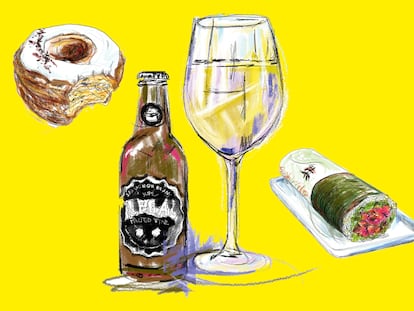What the heck are natural wines anyway?
Everyone’s talking about them, but almost no one is clear on what they are and there is no consensus about whether or not they should be certified. The debate continues

One of the most heated debates in the wine world concerns the use of the adjective “natural” to describe the subject. Is there such a thing as natural wine? If some wines are natural, are others not natural? Who decides which wines are natural and which are not?
The discussion goes back a long way. In the 19th century, for the first time, a distinction was made between natural and artificial wines; in the latter, adjustments are made during production, and they are created by mixing water, ethanol and other substances (a practice that is currently prohibited). At that time, the distinction emerged as a reaction to a novel technique, chaptalization, which consists of sweetening the must to increase the alcohol content after fermentation. Although still used today by a minority of winemakers, not everyone liked chaptalization; among other reasons, because it improved the quality of the wine in areas not amenable to producing good wines, which meant more competition in a market unaccustomed to threats.
In spite of everything, the advance of oenological methods discovered in the second half of the 19th century were imposed on the traditional ways of winemaking. However, in mid 20th-century France, faced with the standardization of acidulants, stabilizers and antiseptics and processes like filtration, a countercurrent emerged, founded by Jules Chauvet, a wine merchant and viticulture expert who began to make wine without sulfur dioxide. Soon, Chauvet’s methods were followed by Jacques Néauport and Marcel Lapierre, in Beaujolais, and Pierre Overnoy, in the Jura; they are all considered to be pioneers of natural wines, as we understand them today.
In Spain, the movement began in 2008 when the Association of Natural Wine Producers (PVN) was founded by 11 wineries, mostly from Catalonia and Andalusia, who rallied around Benoît Valée, a French winemaker who opened l’Ànima del Vi in Barcelona, a charming natural wine bar that had already become a mecca. At the time of the association’s founding, Valée wrote the following: “When someone buys natural orange juice, everyone understands that it is juice that comes from a squeezed orange, nothing else! To those who criticize the term natural wine, let them tell me if sweetened orange juice with added vitamin B, coloring [and] preservatives, which has been refined and pasteurized, still seems to be natural orange juice, just because it comes from an orange.”
Valée hit the nail on the head in the previous paragraph. According to the law on vineyards and wines, which has been in effect since 2003, wine is “the natural foodstuff obtained exclusively by alcoholic fermentation, in whole or in part, from fresh grapes, whether crushed or not, or from grape must.” Thus, one might think that all wines are natural because they come “exclusively” from grapes or must, but it is not that simple.

“People are unaware that wine can have more than 60 ingredients: adjuvants, additives, sulfite levels ranging from zero to 400 milligrams per liter; wine is a paradigmatic example of information asymmetry in the market, because the bottle does not convey to the consumer what the producer does,” says Eva Parga, a researcher at the Institute of Natural Products and Agrobiology (IPNA), a Spanish Research Council center.
As Valée warned, it is difficult to argue that a product with more ingredients than Coca-Cola can be called natural. But since there are wines made from grapes and only grapes, it is worth asking how we should distinguish them, especially when many people who make natural wine believe that they make wine, just wine, and reject the adjective “natural.” “If you work clean and work well, why do you have to justify it and prove it, and not if you fill it with shit, contaminate and poison people?” asks Nacho González, the owner of the La Perdida winery, in Valdeorras, and a member of the PVN. Despite that reluctance, which many winemakers share, the PVN has its own rather loose definition of natural wine: “It is wine made with natural grapes, without adding or removing anything from the grapes. The result is a faithful reflection of the land from which the wine is born.”
On the other side of the Pyrenees mountains, the French are more precise. In 2019, a group of French winemakers created the syndicat de défense des vins naturels [union for the defense of natural wines], an association that goes beyond offering a definition; the irrepressible Gauls have also launched the Vin Méthode Nature label, a label for which wineries from all over the world are eligible.
Jorge Vega is the owner of Puerta del Viento. In 2021, this winery from Bierzo was the first in Spain to obtain the French certificate; it is one of only five that have it outside France. Vega maintains that a natural wine “is made by the winegrower himself; it is the result of organic, biodynamic, regenerative or mixed viticulture; it is made without additives or the use of cold during fermentation and, in addition, all the winemaker’s production is natural.” Unsurprisingly, his point of view coincides with the conditions required to obtain the Vin Méthode Nature certification.
The idea of a certification for natural wines, and thus an official definition of them, has been circulating for some time. In fact, we must return to researcher Eva Parga: for a few years now, she and fellow researcher Pablo Alonso have been conducting an international study on this subject. “Drawing on sociology, anthropology, sensory studies and toxicology, we scientifically analyze whether natural wine is different from conventional wine, what consumers think about whether or not this difference exists and their opinion on whether there should be a certificate that distinguishes natural wines or not,” Alonso explains. Parga and Alonso’s research suggests that the certificate would be welcome. “We asked consumers what they preferred, and, in order of preference, we concluded that the complete list of ingredients should appear, that there should be a certificate for natural wines, that there should not be regulation and that a QR code should be included,” says Parga.

On December 8, 2023, the unjustifiable moratorium exempting the wine industry from listing ingredients on its labels came to an end. That exception has limited the consumer’s right to information since food labeling rules were established in Europe in 1976, and it undergirds the “asymmetry of information in the market” that Parga mentioned above.
From now on, bottles will incorporate a QR code, the least appealing option for consumers, according to the Spanish Research Council study; the code was nevertheless promoted by the Comité Européen des Entreprises Vins (CEEV), a powerful lobby. This QR code will link to a virtual label where ingredients, nutritional information and other data will appear, but it will not include adjuvants, the catalysts of physico-chemical processes that represent about half of what can be added to wine.
While regulation could have been good news, it represents a lost opportunity. Perhaps it is more important today than ever to officially define what natural wine is and consider whether a certification that visually distinguishes it is appropriate. But in the wine world, that generates the fiercest disputes. “The seal would be for the industry, as happened with the eco. The most basic thing would be to put the ingredients, to see if there are eggs,” summarizes Nacho González, who, like many members of the VPN and its supporters, fears that a hypothetical seal would homogenize natural wines, bury winemakers in even more bureaucracy than they already have to deal with and sweep artisan producers out of the market in favor of industrial ones.
However, for winemakers like Jorge Vega, a label is a good idea. “I did it to see how the French seal worked, and I have seen that it is easy and that I can do it, but my motivation is the consumer’s right to information,” this winegrower argues. He adds that in markets with more suspicious consumers, such as the Danish market, certification is an argument in favor of buying a wine.
Sign up for our weekly newsletter to get more English-language news coverage from EL PAÍS USA Edition
Tu suscripción se está usando en otro dispositivo
¿Quieres añadir otro usuario a tu suscripción?
Si continúas leyendo en este dispositivo, no se podrá leer en el otro.
FlechaTu suscripción se está usando en otro dispositivo y solo puedes acceder a EL PAÍS desde un dispositivo a la vez.
Si quieres compartir tu cuenta, cambia tu suscripción a la modalidad Premium, así podrás añadir otro usuario. Cada uno accederá con su propia cuenta de email, lo que os permitirá personalizar vuestra experiencia en EL PAÍS.
¿Tienes una suscripción de empresa? Accede aquí para contratar más cuentas.
En el caso de no saber quién está usando tu cuenta, te recomendamos cambiar tu contraseña aquí.
Si decides continuar compartiendo tu cuenta, este mensaje se mostrará en tu dispositivo y en el de la otra persona que está usando tu cuenta de forma indefinida, afectando a tu experiencia de lectura. Puedes consultar aquí los términos y condiciones de la suscripción digital.
More information
Archived In
Últimas noticias
Welcome to the post-religion era: The idea of Christianity as the absolute truth has become obsolete
‘I thought you would like it’: The risky sexual practice popularized by TV shows and TikTok
The digitalization of tourism: ‘They promise experiences and gave us the worst possible one’
Mexican peso defies uncertainty with forecasts of a new period of stability in 2026
Most viewed
- Sinaloa Cartel war is taking its toll on Los Chapitos
- Oona Chaplin: ‘I told James Cameron that I was living in a treehouse and starting a permaculture project with a friend’
- Reinhard Genzel, Nobel laureate in physics: ‘One-minute videos will never give you the truth’
- Why the price of coffee has skyrocketed: from Brazilian plantations to specialty coffee houses
- Silver prices are going crazy: This is what’s fueling the rally









































